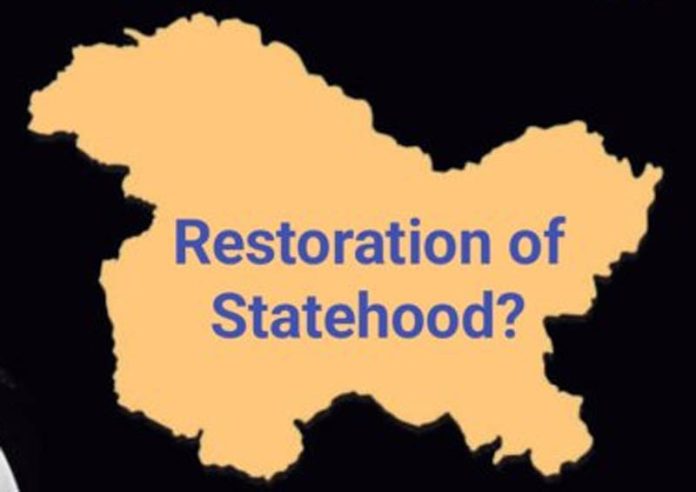M Haziq Pandit
Although Jammuites and Kashmiris differ completely in their views on the nullification of Jammu and Kashmir’s special status, the residents of the two regions remain visibly united in their call for the restoration of statehood to the UT of J&K.
While Jammuites believe that the degradation of the erstwhile state status of Jammu and Kashmir to a union territory snatched important powers from the local rulers, the Kashmiris, on the other hand, feel that the downgrading of the state to a UT has both political and economic ramifications due to the major powers vested with the LG and in turn feel major control of New Delhi over local administration.
Importantly, Article 370, 35-A of the Indian Constitution provided special autonomy to J&K, granting powers to make laws for the state legislature and protecting the rights of ownership for the residents of the erstwhile state. Interestingly, Article 35-A protected the job rights of state subjects, which had been prevalent across the state since 1927 during Maharaja Hari Singh’s rule.
The peeved Kashmiris, however, demand the complete restoration of special status. At the same time, Jammuites called for the restoration of statehood only, as they felt deprived of their right to have jobs and protect their land from residents of other parts of the country. These aspirations have even compelled regional and as well as national parties to include the demand for the restoration of statehood as part of their manifesto in the recently concluded assembly polls in September.
Trying to be docile about Article 370, 35-A, the Jammu and Kashmir National Conference (JKNC) stressed on restoration of statehood in the election manifesto released on August 19, 2024, for the assembly elections-the first in the valley since the abrogation of Article 370 and the bifurcation of the erstwhile state into two Union Territories in 2019. The manifesto included a range of commitments, with a strong focus on ensuring the realization of at least the restoration of statehood at the earliest.
“We strive to restore (Articles) 370, Art. 35-A, and statehood as before August 5, 2019,” the NC poll manifesto said. In the interim period, “we will endeavor to redraw the Jammu and Kashmir Reorganization Act, 2019, and the Transaction of Business of the Government of Union Territory of Jammu and Kashmir Rules, 2019”, it said. The NC promised that their first task after resumption of power following the assembly election, would be to pass a resolution opposing the central government’s decision to revoke the region’s statehood and special status. However, they passed the resolution of restoration of statehood but avoided mentioning about restoration of special status envisaged under article 370, 35 A, in its first cabinet meet. CM Omar Abdullah even personally took a copy of the resolution to the Central Government through LG Manoj Sinha.
On October 23, CM Omar Abdullah met with Home Minister Amit Shah, followed by a meeting with Prime Minister Narendra Modi on October 24, during which he called for the restoration of statehood for the UT.
The top BJP leadership assured CM Omar that it would be accomplished at an appropriate time in the wake of the spurt in terror attacks in Kashmir in recent times. Some sources indicated that the proposal may be taken up in the winter session of Parliament beginning in November.
J&K BJP General Secretary Ashok Koul said on 24th October that a final call regarding the restoration of statehood in J&K can be taken only if attacks like those in Gagangeer and Ganderbal stop.
“PM Narendra Modi and the Union Home Minister are on record about restoration of statehood to J&K at an appropriate time. Now it’s the agencies and the Centre that would take a call on whether statehood needs to be restored,” Koul said. He added that a call for the restoration of statehood would be taken only if attacks like those in Gagangeer stop. “Perhaps the timing of the attack in Gagangeer was wrong; otherwise, there would have been casualties among hundreds of workers,” he said.
However, even if statehood for J&K is granted, the CM and LG are likely to be at loggerheads over several issues, as the governance structure might mirror that of Delhi, where the chief minister has limited powers.
Many powers would, however, remain vested with the central government, such as police, public order, Revenue and Finance. This would mean that the CM could struggle to enact policies without the Central Government’s backing, thus reducing him to a toothless CM.
The Governor may also retain considerable influence over local governance. The Governor’s authority could include the ability to dismiss the assembly or intervene in state matters, which would further undermine the CM’s authority. Additionally, the Governor will hold power over financial matters, such as budget approvals.
Zahoor Ahmad Bhat, a lecturer and one of the petitioners against the revocation of Article 370, said that statehood was the right of the people of J&K, as representatives should be able to make laws and work for their constituents after elections. He added that the people did not want a ‘toothless’ CM and representatives in J&K due to the UT status.
Trending Now
E-Paper


